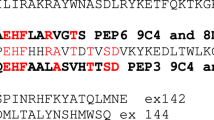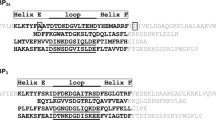Summary
C-protein is an abundant protein, of unknown function, found in the striated muscles of all vertebrates (Offeret al., 1973). Based on differences in size, charge, antigenicity and sarcomere distribution, at least three different isoforms of this protein have been identified (Callaway & Bechtel, 1981; Yamamoto & Moos, 1983; Reinachet al., 1982; Dhootet al., 1985). These have been termed fast-, slow-and cardiac-type isoforms, relative to their distribution in adult striated muscles. Each of these isoforms appears to be expressed sequentially during the development of the chicken pectoralis muscle (Obinataet al., 1984; Obinata, 1985). To better characterize the various isoforms of C-protein, we have reexamined itsin vivo expression during avian myogenesis using a combination of 1-and 2-dimensional gel electrophoresis, cell-free translation and immunoblotting procedures. In this manuscript we demonstrate for the first time that at least four major C-protein isoforms can be distinguished in adult chicken muscles. These include a fast-type isoform in the pectoralis (PECT) muscle (Cnf), a slow-type isoform in the anterior latissimus dorsi (ALD) muscle (Cs3), a second slow-type isoform in the posterior latissimus dorsi (PLD) muscle (Cs4) and a cardiac-type in the ventricle (Cc). During embryonic development of the PECT muscle two additional isoforms can be resolved. These are both slow-type isoforms based on their reactivities with ALD66, a monoclonal antibody specific for adult slow-type C-protein. These latter isoforms have been termed Cs1 and Cs2. Several of the isoforms, particularly Cns1 ands Cs3, exhibit two or more spots of different charge but identical molecular weight on 2-D gels. This observation suggests the possibility that these isoforms are post-translationally modified and possibly phosphorylated. Our data show the C-protein family in avian striated muscles to be highly complex. Additional genetic analyses and primary sequence studies will be required to distinguish transcriptional from post-transcriptional variants.
Similar content being viewed by others
References
Auffray, C. &Rougeon, R. (1980) Purification of mouse immunoglobin heavy chain messenger RNAs from total myoloma tumor RNA.Eur. J. Biochem. 107, 303–14.
Bennett, P., Craig, R., Starr, R. &Offer, G. (1986) The ultrastructural location of C-protein, X-protein and H-protein in rabbit muscle.J. Muscle Res. Cell Motil. 7, 550–67.
Bouche, M., Goldfine, S. &Fischman, D. (1988) Post-translational incorporation of contractile proteins into myofibrils in a cell-free system.J. Cell Biol. 107, 587–96.
Callaway, J. &Bechtel, P. (1981) C-protein from rabbit soleus (red) muscle.Biochem. J. 195, 463–69.
Cleveland, D., Fisher, S., Kirschner, M. &Laemmli, U. (1977) Peptide mapping by limited proteolysis in sodium dodecyl sulfate and analysis by gel electrophoresis.J. Biol. Chem. 252, 1102–06.
Craig, R. &Offer, G. (1976) The location of C-protein in rabbit skeletal muscle.Proc. R. Soc. Lond. B Biol. Sci. 192, 451–61.
Davis, J. (1988) Interaction of C-protein with pH 8.0 synthetic thick filaments prepared from the myosin of vertebrate skeletal muscle.J. Muscle Res. Cell Motil. 9, 174–83.
Dennis, J., Shimizu, T., Reinach, F. &Fischman, D. (1984) Localization of C-protein isoforms in chicken skeletal muscle: ultrastructural detection using monoclonal antibodies.J. Cell Biol. 98, 1514–22.
Dhoot, G., Hales, M., Grail, B. &Perry, S. (1985) The isoforms of C-protein and their distribution in mammalian skeletal muscle.J. Muscle Res. Cell Motil. 6, 487–505.
Einheber, S. &Fischman, D. (1987) Evidence for the isolation of a cDNA clone encoding fast muscle C-protein.J. Cell Biol. 105, 118a.
Einheber, S. &Fischman, D. (1988) Isolation and initial characterization of a cDNA clone encoding avian skeletal muscle C-protein.UCLA Symp. Molec. Cell. Biol. 93NS, 523–34.
Hartzell, H. (1985) Effects of phosphorylated and unphosphorylated C-protein on cardiac actomyosin ATPase.J. Mol. Biol. 186, 185–195.
Hartzell, H. &Glass, D. (1984) Phosphorylation of purified cardiac muscle C-protein by purified cAMP-dependent and endogenous Ca2+-calmodulin-dependent protein kinases.J. Biol. Chem. 259, 15587–96.
Hartzell, H. &Titus, L. (1982) Effects of cholinergic and adrenergic agonists on phosphorylation of a 165 000-dalton myofibrillar protein in intact cardiac muscle.J. Biol. Chem. 257, 2111–20.
Hirabayashi, T. (1981) Two-dimensional gel electrophoresis of chicken skeletal muscle proteins with agarose gels in the first dimension.Anal. Biochem. 117, 443–51.
Hirabayashi, T., Tamura, R., Mitsui, I. &Watanabe, Y. (1983) Investigation of actin inTetrahymena cells. A comparison with skeletal muscle actin by a devised two-dimensional gel electrophoresis method.J. Biochem. 93, 461–8.
Jeacocke, S. &England, P. (1980) Phosphorylation of a myofibrillar protein of Mr 150 000 in perfused rat heart, and the tentative identification of this as C-protein.FEBS Lett. 122, 129–32.
Kawashima, M., Kitani, S., Tanaka, T. &Obinata, T. (1986) The earliest form of C-protein expressed during striated muscle development is immunologically the same as cardiac-type C-protein.J. Biochem. 99, 1037–47.
Koretz, J. (1979) Effects of C-protein on synthetic myosin filament structureBiophys. J. 27, 433–46.
Laemmli, U. (1970) Cleavage of structural proteins during the assembly of the head of bacteriophage T4.Nature (Lond.) 227, 680–85.
Maniatis, T., Fritsch, E. &Sambrook, J. (1982)Molecular Cloning. A Laboratory Manual. Cold Spring Harbor Laboratories, New York, 196–98.
Mikawa, T., Takeda, S., Shimizu, T. &Kitaura, T. (1981) Gene expression of myofibrillar proteins in single muscle fibers of adult chicken: micro two-dimensional gel electrophoresis analysis.J. Biochem. 89, 1951–62.
Moos, C. (1981) Fluorescence microscope study of the binding of added C-protein to skeletal muscle myofibrils.J. Cell Biol. 90, 25–31.
Moos, C., Offer, G., Starr, R. &Bennett, P. (1975) Interaction of C-protein with myosin, myosin rod and light meromyosin.J. Mol. Biol. 97, 1–9.
Moos, C., Mason, C., Besterman, J., Feng, I. &Dubin, J. (1978) The binding of skeletal muscle C-protein to F-actin, and its relation to the interaction of actin with myosin subfragment-1.J. Mol. Biol. 124, 571–86.
Obinata, T. (1985) Changes in myofibrillar protein isoform expression during chicken skeletal muscle development.Zool. Sci. 2, 833–47.
Obinata, T., Reinach, F., Bader, D., Masaki, T., Kitani, S. &Fischman, D. (1984) Immunochemical analysis of C-protein isoform transitions during the development of chicken skeletal muscle.Devel. Biol. 101, 116–24.
O'Farrell, P. (1975) High resolution two-dimensional electrophoresis of proteins.J. Biol. Chem. 250, 4007–21.
O'Farrell, P., Goodman, H. &O'Farrell, P. (1977) Heigh resolution two-dimensional electrophoresis of basic as well as acidic proteins.Cell 12, 1133–41.
Offer, G. (1972) C-protein and the periodicity in the thick filaments of vertebrate skeletal muscle. Cold Spring Harbor Symp,Quant. Biol. 37, 87–93.
Offer, G., Moos, C. &Starr, R. (1973) A new protein of the thick filaments of vertebrate skeletal myofibrils. Extraction, purification and characterization.J. Mol. Biol. 74, 653–76.
Pelham, H. &Jackson, R. (1976) An efficient mRNA-dependent translation system from reticulocyte lysates.Eur. J. Biochem. 67, 247–56.
Pepe, F. &Drucker, B. (1975) The myosin filament, III. C-protein.J. Mol. Biol. 99, 609–17.
Reinach, F., Masaki, T., Shafiq, S., Obinata, T. &Fischman, D. (1982) Isoforms of C-protein in adult chicken skeletal muscle: Detection with monoclonal antibodies.J. Cell Biol. 95, 78–84.
Reinach, F., Masaki, T. &Fischman, D. (1983) Characterization of the C-protein from posterior latissimus dorsi muscle of the adult chicken: heterogeneity within a single sarcomere.J. Cell Biol. 96, 297–300.
Starr, R. &Offer, G. (1978) The interaction of C-protein with heavy meromyosin and subfragment-2.Biochem J. 171, 813–16.
Starr, R. &Offer, G. (1982) Preparation of C-protein, H-protein, X-protein, and phosphofructokinase.Meth. Enzymol. 85, 130–38.
Starr, R. &Offer, G. (1983) H-protein and X-protein: Two new components of the thick filaments of vertebrate skeletal muscle.J. Mol. Biol. 170, 675–98.
Yamamoto, K. (1986) The binding of skeletal muscle C-protein to regulated actin.FEBS Lett. 208, 123–27.
Yamamoto, K. &Moos, C. (1983) The C-proteins of rabbit red, white, and cardiac muscles.J. Biol. Chem. 258, 8395–401.
Takano-Ohmuro, H., Goldfine, S. &Fischman, D. (1987) Size and charge heterogeneity of slow-type isoforms in chicken striated muscle.Biophys. J. 51, 314a.
Author information
Authors and Affiliations
Rights and permissions
About this article
Cite this article
Takano-Ohmuro, H., Goldfine, S.M., Kojima, T. et al. Size and charge heterogeneity of C-protein isoforms in avian skeletal muscle. Expression of six different isoforms in chicken muscle. J Muscle Res Cell Motil 10, 369–378 (1989). https://doi.org/10.1007/BF01758433
Issue Date:
DOI: https://doi.org/10.1007/BF01758433




